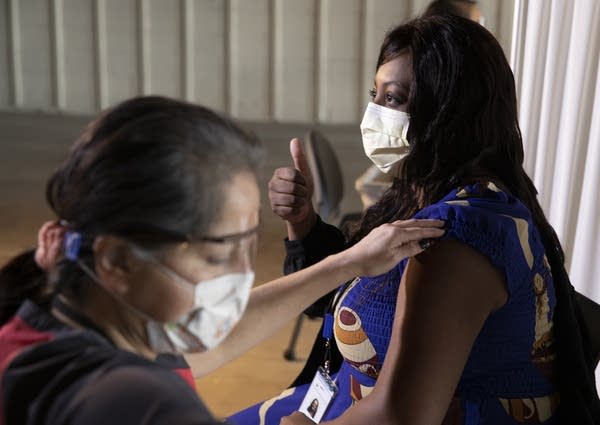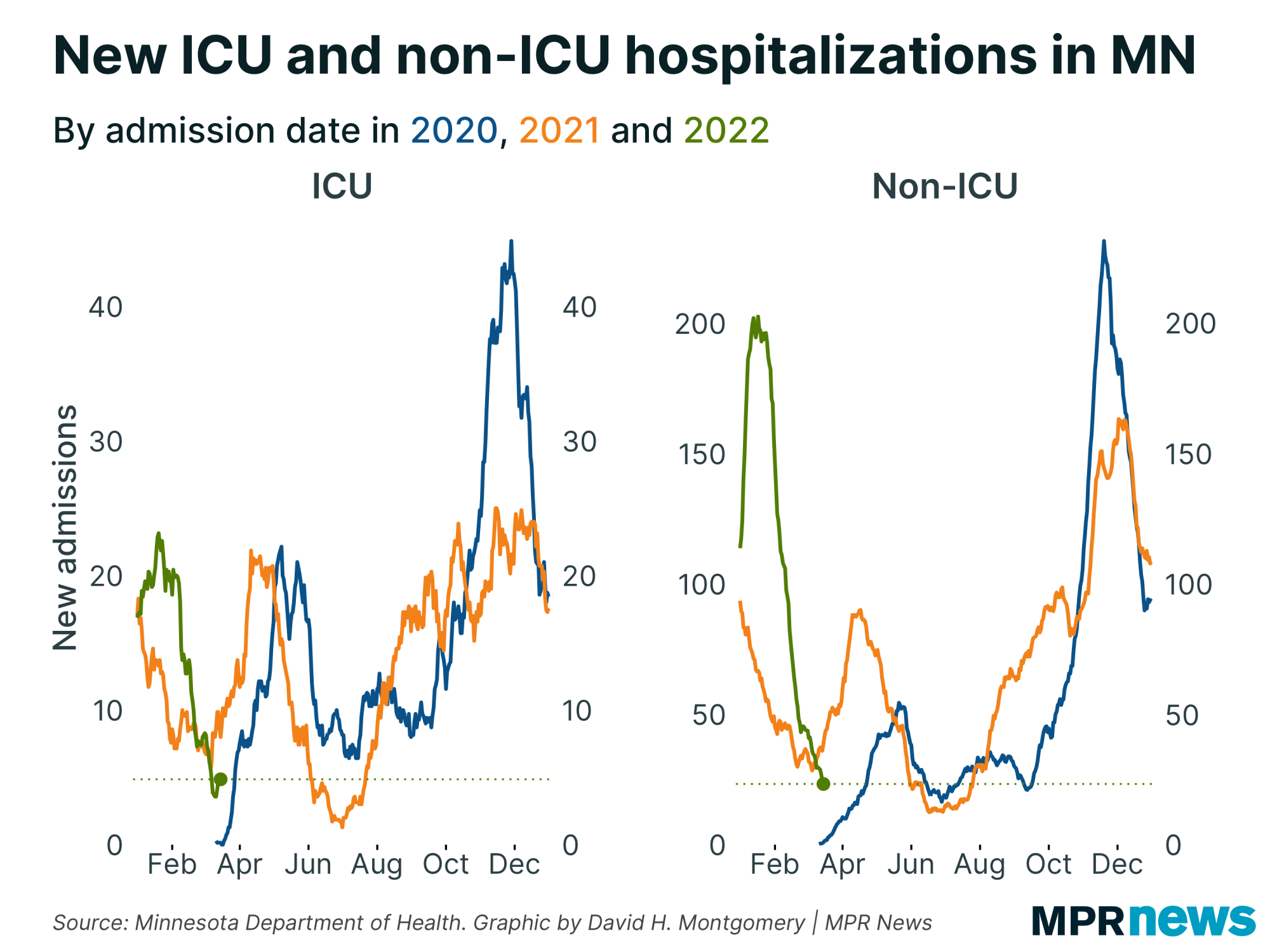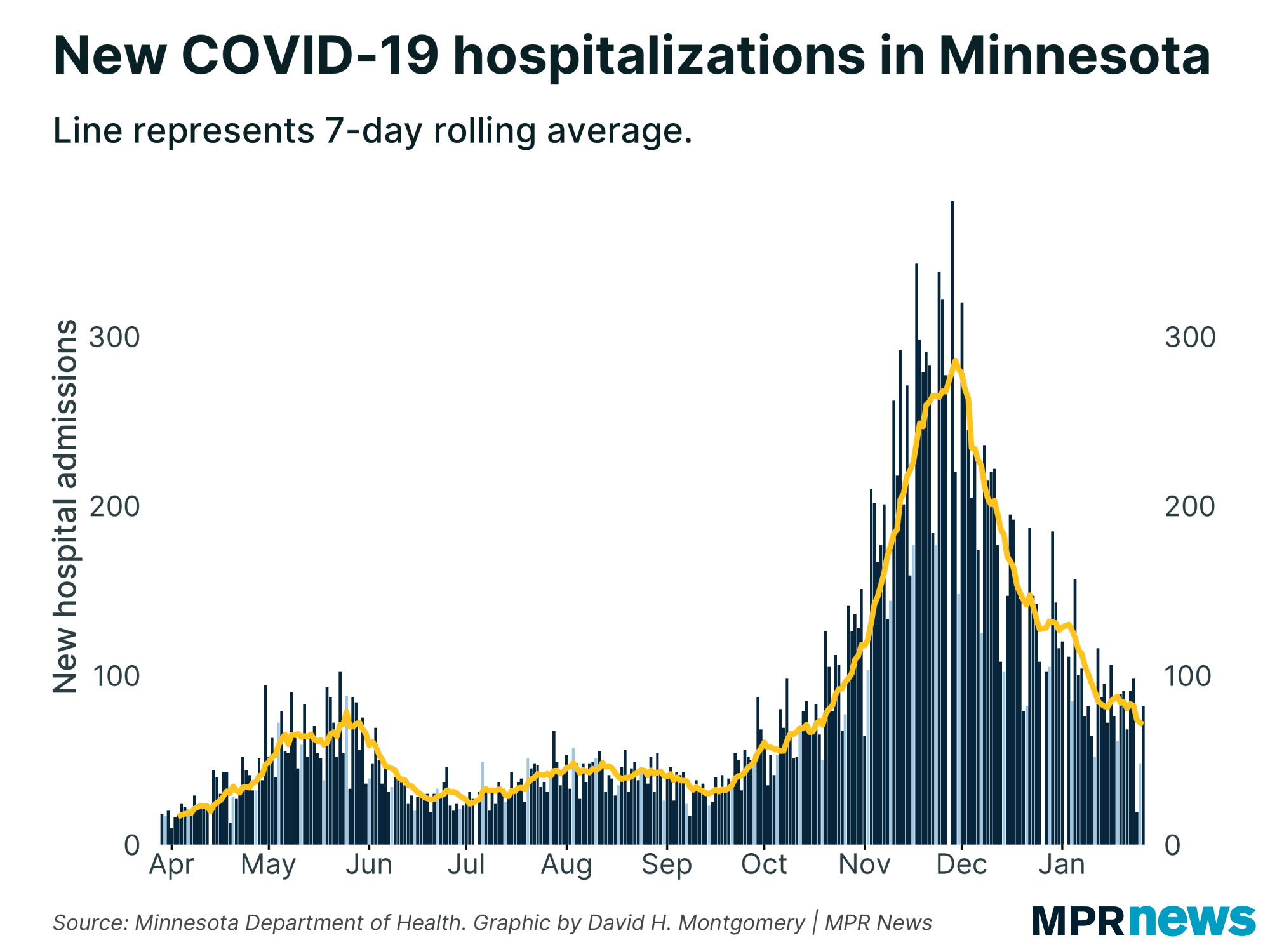Jan. 22 update on COVID-19 in MN: 21 deaths; trends hopeful, but vaccinations flat

Go Deeper.
Create an account or log in to save stories.
Like this?
Thanks for liking this story! We have added it to a list of your favorite stories.
Updated 3:43 p.m.
Minnesota’s COVID-19 data continues to show the state on a hopeful, steady path in January following an awful November and December.
Health officials on Friday reported 1,525 newly confirmed or probable cases of the disease — along with 21 more deaths; 558 people were in the hospital with COVID-19 at last count, with 98 needing intensive care. ICU cases remain at four-month lows.

Active cases ticked up but still remain below 12,000. Two months ago, the number of active COVID-19 cases in the state hovered around 50,000.

The downside at this point appears to be coming from the state’s vaccination efforts, which remain flat in the early stages. As of Monday, about 4 percent of the state’s population had received a dose and about 1 percent had a completed vaccination series.
Turn Up Your Support
MPR News helps you turn down the noise and build shared understanding. Turn up your support for this public resource and keep trusted journalism accessible to all.
The newest reports come a day after the state’s top health officials said Minnesota appears to have dodged a major post-holiday surge in COVID-19 cases.
Public health leaders had worried that gatherings of family and friends for Christmas and New Year’s Eve would deliver a wave of cases three or four weeks later. But new caseloads stayed modest, as they did following Thanksgiving.
“While we could still see an increase in cases as a result of the New Year's holiday in particular, the evidence does suggest that we may have already seen our post-holiday spike, that thankfully it was a modest and manageable one,” Health Commissioner Jan Malcolm told reporters.
The latest COVID-19 cases put Minnesota at 452,268 in the pandemic. Of those, about 96 percent have recovered to the point they no longer need to be isolated.

The newly reported deaths raised Minnesota’s toll to 6,032. Among those who’ve died, about 64 percent had been living in long-term care or assisted living facilities; most had underlying health problems.

Cases spread across age groups, regions
People in their 20s still make up the age bracket with the state’s largest number of confirmed cases — more than 86,000 since the pandemic began, including more than 45,000 among people ages 20 to 24.

The number of high school-age youth confirmed with the disease has also grown, with nearly 35,000 total cases among those ages 15 to 19 since the pandemic began.
Although less likely to feel the worst effects of the disease and end up hospitalized, experts worry youth and young adults will spread it to older relatives and members of other vulnerable populations.
It’s of particular concern because people can have the coronavirus and spread COVID-19 when they don’t have symptoms.
Caseloads continue to trend down across all regions of the state following a late December, early January blip.

Hot spots continue to pop up in rural counties relative to their population.

Caseloads still heaviest among people of color
In Minnesota and across the country, COVID-19 has hit communities of color disproportionately hard in both cases and deaths. That’s been especially true for Minnesotans of Hispanic descent for much of the pandemic.

Even as new case counts ease from their late November, early December peaks, the data shows people of color continue to be hit hardest.
Distrust of the government, together with deeply rooted health and economic disparities, have hampered efforts to boost testing among communities of color, officials say, especially among unauthorized immigrants who fear their personal information may be used to deport them.
Similar trends have been seen among Minnesota’s Indigenous residents. Counts among Indigenous people jumped in October relative to population.
Vaccination frustrations boil
Even as the overall pandemic numbers continue to improve, Minnesota officials face a new difficult challenge to get Minnesotans inoculated as quickly as possible.
There is far more demand for vaccine than supply and the state is struggling to gain traction in its efforts to get shots into arms.
About 12,000 doses — roughly 20 percent of Minnesota’s current weekly allocation — are being distributed to nine sites around the state, part of a pilot program intended to speed vaccinations to people 65 and older as well as to educators and child care workers.
But the online booking process that launched at noon Tuesday quickly became overwhelmed, getting more than 1 million hits by early afternoon.
The first-day problems created serious frustration for many. Stories of unhappy seniors trying but failing to secure an appointment online or by phone bubbled across social media.
Officials said later the state anticipates providing first-dose shots to all 12,000 people — 6,000 seniors and 6,000 educators and child care providers — who have appointments at pilot clinics through the weekend.

Minnesota has administered first doses to more than 214,000 people across the state, and 49,604 have received their second dose, according to the state's dashboard.
That’s from about 670,000 doses of COVID-19 vaccine that have been shipped to Minnesota so far, including the federal program for long-term care facility vaccinations.
Officials are tempering optimism about supplies increasing under the Biden administration with caution that the needed volume is not here yet. Gov. Tim Walz on Friday said if the Biden administration can reach its goal of 100 million doses of COVID-19 vaccinations within 100 days, Minnesota will likely get enough vaccine to come close to reaching herd immunity — when a large enough percentage of a population is protected against a disease that it's less likely to spread from person to person.
For Minnesota to reach that point, the state will need about 3 million doses, Walz said.
"At the rate we're at, this is where the frustration lies, it's not fast enough,” the governor said as he, alongside Malcolm, visited a rehabilitation center in New Hope, Minn. They applauded efforts to vaccinate some high-risk populations but also acknowledged frustration over the limited availability of the vaccine.
Latest developments
State wants students, youth athletes tested for COVID
Minnesota health officials on Thursday called for expanded COVID-19 testing, urging K-12 and college students returning to campus, along with kids playing youth sports and anyone else “who regularly interacts with people outside of their family unit or household” be tested.
The move expands the number of people the state says should get a test.
While everyone returning to school should get tested, it’s especially important for people ages 12 to 25 because they’re so active, said Dan Huff, a Minnesota Health Department assistant commissioner.
Getting tested should be a “family affair,” he added, noting (not incorrectly) that “most children do like to spit.”
— MPR News Staff
Morgue site won’t be used to store vaccine
The cold-storage facility Minnesota purchased for use as a possible COVID-19 morgue won’t be used to hold vaccine, a top state official said Thursday.
Doses shipped to the state go directly to medical sites for use as fast as possible, and putting them in a warehouse would run counter to that purpose, Minnesota Management and Budget Commissioner Jim Schowalter told the Senate Finance Committee.
The facility in St. Paul was retrofitted to house human remains if funeral homes were overwhelmed by coronavirus deaths.
Minnesota paid about $7 million for the facility, with about $4 million of that reimbursed by the federal government. Throughout the pandemic, some cities and states have had to resort to refrigerator trucks to hold remains because their traditional morgues ran out of space. Gov. Tim Walz said he wanted to make sure remains were dealt with in a dignified manner.
— Brian Bakst | MPR News
Top headlines
Older Minnesotans with new COVID vaccine appointments get shots, but others remain frustrated: Vaccinations for people age 65 and older have started at nine sites across Minnesota and continue through Saturday. The pilot program, new this week, was quickly overwhelmed and officials say they are working out some problems ahead of another signup scheduled for Tuesday.
What you need to know about COVID-19 testing for students: State health officials are now urging COVID-19 testing for children and college students who are returning to school. The announcement Thursday formally expands the list of who should seek a coronavirus test, and comes days after thousands of elementary school students began attending school in person for the first time in months.
Minnesota lost nearly 50,000 jobs in December with pandemic rules in place: More than 80 percent of the job losses in December were in the leisure and hospitality sector. But the DEED reported that there are signs that many of December's job losses may be short-term. The agency said a survey of people who lost jobs in December found that just 10 percent said their job loss was permanent.
Why some providers in Minnesota are getting vaccinated and some aren’t: As the state expands who is eligible for the COVID-19 vaccine, some health care providers say they still don’t know how and when they will get theirs. Demographics, vaccine supply and inconsistent rules are adding to the confusion.
COVID-19 in Minnesota
Data in these graphs are based on the Minnesota Department of Health's cumulative totals released at 11 a.m. daily. You can find more detailed statistics on COVID-19 at the Health Department website.


